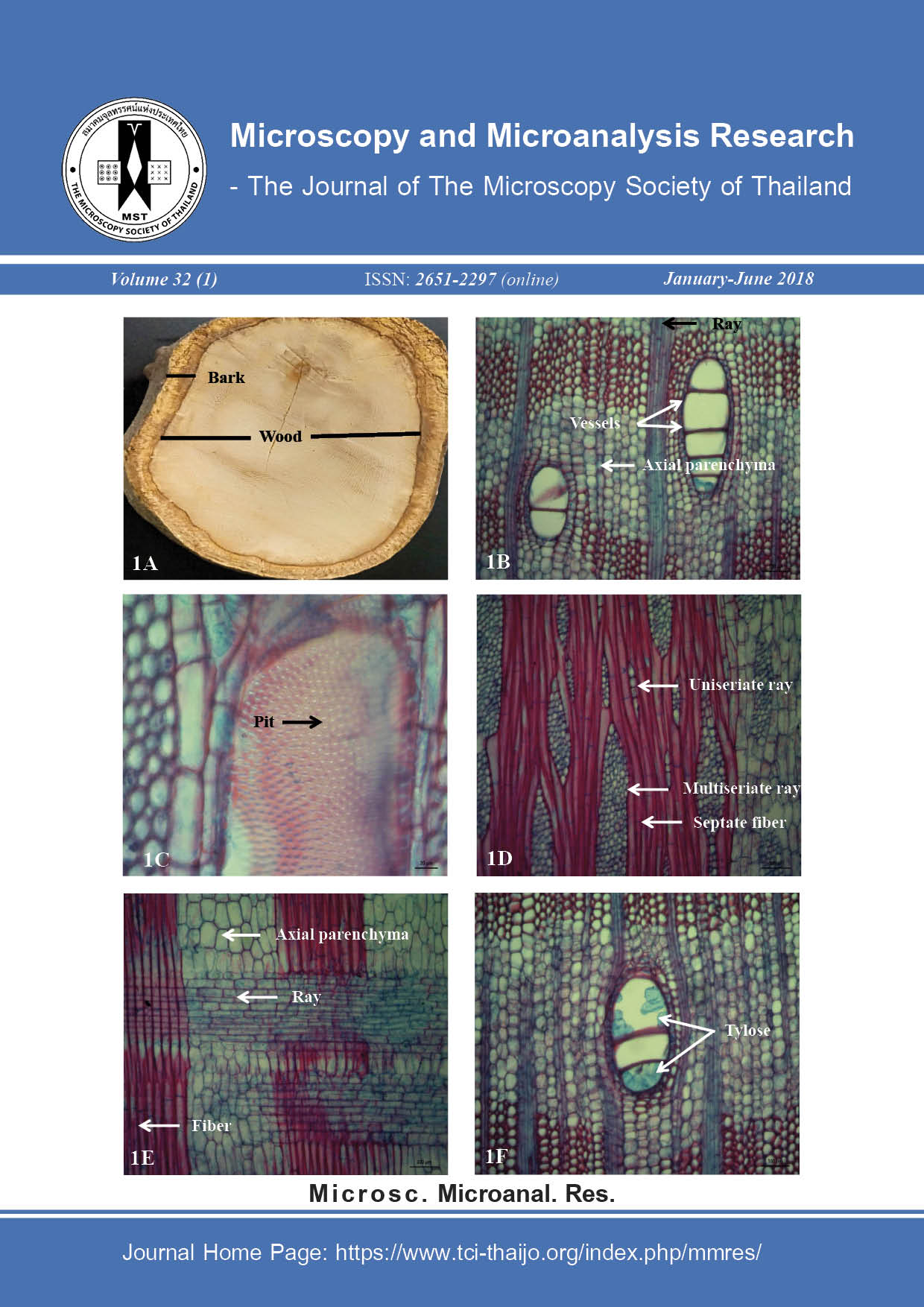Prevalence of Haplorchoides sp. Metacercariae and Comparative Morphology of Infected and Uninfected Scales in Cyprinoid fishes from Li River, Lamphun Province
Main Article Content
Abstract
Cyprinoid fish has been reported to have a large number of metacercariae, particularly the Haplorchoides metacercaria. In this study, the prevalence of Haplorchoides metacercaria was carried on 34 spiny barb fishes (Mystacoleucus marginatus) and 13 bonylip barb fishes (Osteochilus vittatus) collected during August 2017 to March 2018 from the Li River in Lamphun province of Thailand. Morphology of infected scale was observed under light and scanning electron microscope (LM and SEM). The results revealed 100% Haplorchoides metacercarial infection was prevalence in spiny barb fishes. The highest prevalence was found in the scales of the head part (55.2%), followed by the body part (41.3%) and the tail part (34.9%). However, the prevalence of such infection was observed for 69.2% in bonylip barb fishes which was highest in the head part (27.2%), followed by the body part (23.6%) and the tail part (22.3%). The recovered Haplorchoides sp. metacercaria was rounded shape with 2 cyst wall layers. The larval stage within cyst revealed the body surface covered with spines, saccular-shaped excretory bladder and three groups of acetabular spines. With LM and SEM observation, both species of uninfected fish showed the cycloid-shaped scales, thin, smooth surface, and no have spine in posterior part. Each scale consisted of focus, circuli and radii on the surface. The infected metacercarial scale showed the traces of metacercarial embedding which revealed the circular feature, thick and cracked at the ventral part of scales. The area around metacercarial embedding was surrounded by the thick capsule.
Article Details
References
[2] J.C. Pearson, C.K. OW Yang, New species of Haplorchis from Southeast Asia, together with keys to the Haplorchis Group of Heterophyid trematodes of the region, Southeast. Asian. J. Trop. Med. Public. Health., 1982, 13(1), 35 – 60.
[3] S. Yamaguti, Systema Helminthum Vol I. The Digenetic of Vertebrates. Part I and II, Interscience Publisher Inc., New York, 1958.
[4] B.P. Pande, R.P. Shukla, Haplorchoides Chen, 1949 (Hap- lorchinae: Heterophyidae) in freshwater fishes, J. Helminthol., 1976, 50, 181 – 192.
[5] U. Shameem, R. Madhavi, The morphology, life-history and systematic position of Haplorchoides mehrai Pande and Shukla, 1976 (Trematoda: Heterophyidae), J. Syst. Parasitol., 1988, 11, 73 – 83.
[6] T. Scholz, O. Ditrich, M. Giboda, Differential diagnosis of opisthorchiid and heterophyid metacercariae (Trematoda) in- fecting flesh of cyprinid fish from Nam Ngum Dam Lake in Laos, Southeast Asian J. Trop. Med. Public. Health., 1991, 22, 171 – 173.
[7] S. Saenphet, C. Wongsawad, K. Saenphet, A survey of Helminths in freshwater animals from some areas in Chiang Mai, Southeast Asian J. Trop. Med. Public. Health., 2001, 32(2), 2102 – 2113.
[8] C. Nithikathkul, C. Wongsawad, Prevalence of Haplorchis taichui and Haplorchoides sp. metacercariae in freshwater fish from water reservoirs, Chiang Mai, Thailand, Korean J. Parasitol., 2008, 46(2), 109 – 112.
[9] W. Noikong, C. Wongsawad, A. Phalee, Seasonal variation of metacercariae in cyprinoid fish from Kwae Noi Bamroongdan Dam, Phitsanulok Province, northern Thailand, Southeast Asian J. Trop. Med. Public. Health., 2011, 42(1), 58 – 62.
[10] Y. Manpratum, W. Kaewkes, P. Echubard, B. Sripa, S. Kaewkes, New locality record for Haplorchoides mehrai and possible interactions with Opisthorchis viverrini metacercariae in cyprinid fishes in Northeast Thailand, Parasitol. Res., 2017, 116, 601 – 608.
[11] K. Apiwong, C. Wongsawad, P. Butboonchoo, Morphological and molecular characterization of Haplorchoides mehrai Pande and Shukla 1976 (Digenea: Heterophyidae) from Chiang Mai province, Helminthologia, 2018, 55(4), 334-342.
[12] G.A.K. Kirrella, N.M. Elhawary, E.K. Bazh, S.S.Gh. Sorour, K.M. El-Dakhly, Oreochromis niloticus and Clarias gariepinus Fish Infected with Digenean Metacercariae: Experimental Infection of Puppies and Some Chemical Alterations in Fish, Asian J. Anim. Vet. Adv., 2018, 13(4), 352-359.
[13] S. Aly, I. Eissa, A. Badran, M. Elamie, B. Hussain, Pathological Studies on Encysted Metacercariae Infections among some Freshwater Fish in Egyptian Aquaculture, 2005
[14] L.A. Jawad, Comparative morphology of scales of four teleost fishes from Sudan and Yemen. J Nat. Hist., 2005. 39(28), 2643-2660.
[15] H.R. Esmaeili, Z. Gholami, Scanning electron microscopy of scales in cyprinid fish, Alburnoides bipunctatus (Blotch, 1782), Iran J Fish Sci, 2008, 10(1), 155-166.
[16] H.R. Esmaeili, A. Gholamifard, N. Zarei, A. Arshadi, Scale structure of a cyprinid fish, Garra Rossica (Nikol’skii, 1900) using scanning electron microscope (SEM). Iran J Sci. Tech., 2012, A4, 487-492.
[17] M.A.M. Ganzon, M.A.J. Torres, J.J. Gorospe, C.G. Demayo, Variations in Scale Morphology between Sexes of the Spotted Barb, Puntius Binotatus (Valenciennes, 1842) (Actinopterygii: Cyprinidae), International Conference on Environment and Bio Science, 2012, IPCBEE Vol. 44.
[18] P. Suntaravitun, Ng. Dokmaikaw, Prevalence of Trematode Metacercariae in Cyprinoid Fish from Mae Lao District in Chiang Rai Province, KKU Sci. J., 2014, 42(3), 544-550.
[19] T.R. Roberts, The freshwater fishes of Western Borneo (Kalimantan Barat, Indonesia, Mem. Calif. Acad. Sci, 1989, 14, 210.
[20] K.P. Lim, K.L. Ng, A Guide to the Freshwater Fishes of Singapore. Singapore Science Centre, 1990.
[21] S.G. Duran, D. Arola, E.A. Oss, Effect of chemical composition and microstructure on the mechanical behavior of fish scales from Megalops Atlanticus, J Mech Behav Biomed Mater., 2016, 56, 134–145.
[22] V.G.V. Paller, S. Uga, Attachment and penetration of centrocestus armatus (digenea: heterophyidae) cercariae to gills of secondary Intermediate fish hosts, J Parasitol, 2008, 94(3), 578-583.
[23] C. Donthaisong, P. Arunsan, K. Suwannatrai, S. Prasopdee, J. Kulsantiwong, S. Wongmaneeprateep, A. Suwannatrai, S. Tesana, Infectivity and development of Opisthorchis viverrini metacercariae inimmuno suppressed Barbonymus gonionotus fingerlings (Cyprinidae), Acta Tropica, 2016, 162, 107–113.


